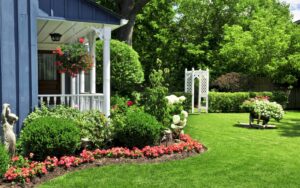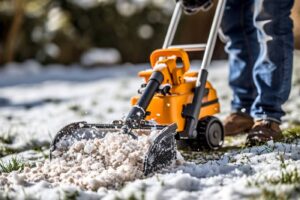Winter is just around the corner, but the need for lawn care isn’t over quite yet. In fact, this time of year can be the most crucial season for the health of your lawn and garden.
Taking time to properly winterize your landscape this fall will help prepare your lawn and garden for spring. Here’s how to winterize your landscape and pave the way for a lush green landscape in spring from the Highland Park lawn care experts at Keane Landscaping.
Know Your Grass. This is step one. Know what kind of grass you have in order to know just what your lawn needs this fall. Cool-season grasses, such as fescue, Kentucky bluegrass and perennial ryegrass benefit most from a fall dose of fertilizer. Warm-season grasses like Bermuda, centipede, St. Augustine and zoysia require different treatment, depending on the climate.
To Fertilize or Not? Knowing the type of grass you have will help determine whether or not your lawn needs to be fertilized this fall. Cool-season grasses benefit most from fall fertilization because the shorter days and cooler air trigger cool-season plants and grass to slow growth and shift their food reserves from leaves to roots. This is the secret to your plants returning in spring. On the other hand, warm-season grasses in climates where the weather drops below freezing in late fall will go dormant in winter and do not need to be fertilized after September 1. In milder climates where warm-season grass stays great year round, a slow-release nitrogen fertilizer should be applied in early autumn to fuel long-term growth.
Prune and Weed. Perennial weeds compete for nutrients with the rest of your landscape, so it’s critical that they are removed before winter weather sets in. Pruning is more enjoyable in the cool fall weather, and easier done now, before winter’s freeze kicks in and you have to wrestle with frozen foliage. Taking time to do these tasks now will make your lawn more manageable come spring.
Remove Debris. Do not let dead leaves sit on your lawn all winter. Instead, rake and remove them to prevent mold and disease. Raking your lawn in the fall also helps remove the dead thatch layer on top of your lawn, which can prevent water and nutrients from reaching the roots.
Spread Grass Seed. When daytime temperatures reach between 60 and 70 degrees Fahrenheit, it’s the prime time to spread new cool-weather grass seed across your lawn. Seeding during the fall will help fill in patches and holes, providing you a beautiful, thick, lush landscape in the spring.
Cover Plant Beds. Insulate the topsoil of your flower and vegetable beds from harsh winter temps by adding mulch, planting a cover crop or covering the bed with burlap. Repot small plants and bring them indoors. Know what kind of bulbs you have, as some bloom best in spring after a cold winter, while other bulbs are more tender and may need to ride out winter inside.
Care for Your Hardscapes. Fountains, water features and other hardscapes may also need some attention before winter weather arrives. To determine what needs to be done, check with your landscape design and installation team.
If winterizing your landscape seems like a big task, contact the Highland Park lawn care experts at Keane Landscaping to learn more about our winter maintenance service options.






